This Dutch Oven No Knead Bread is the perfect way to make a delicious, crusty artisan loaf in the comfort of your own home! Best of all? It takes only FIVE MINUTES of prep, and you don’t have to ever touch the sticky dough with your hands! With a short, two-hour total rise time, you can make this for dinner tonight.
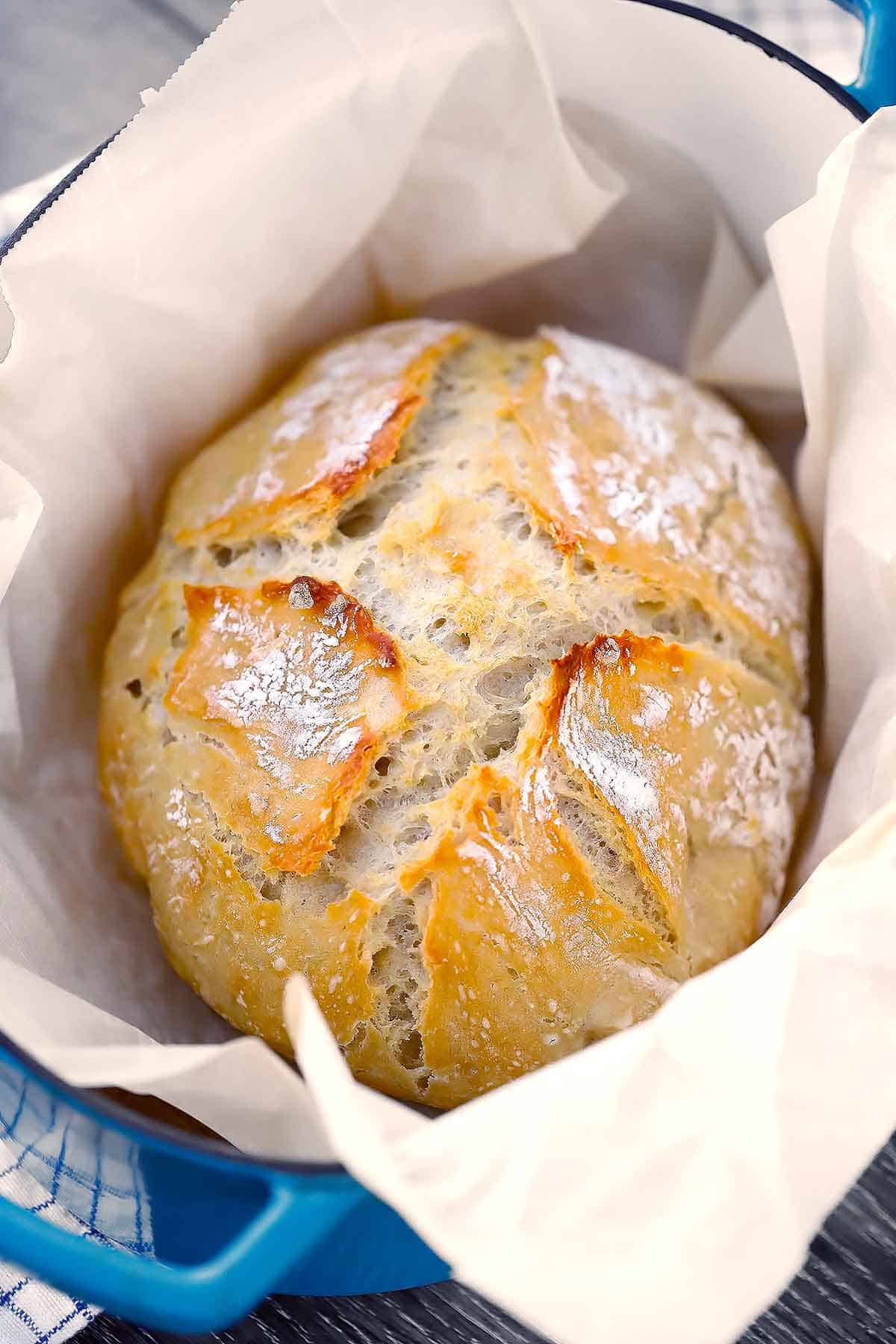
I’m a good cook. I mean, I’m allowed to brag about that… I’ve built a career out of it with this website. But until now, I’ve had the HARDEST time making a good homemade bread.
Am I alone in this? Homemade bread has always eluded me and been a real challenge. My homemade breads have always been too flat, too dry, too hard, too annoying and sticky to work with, etc.
UNTIL NOW.
YOU GUYS. I finally cracked the code for homemade bread that isn’t a hassle and is so amazingly delicious, moist, with fluffy holes, and with the perfect crusty crust!
You can use all-purpose flour – no need for fancy bread flour!
This is the only no knead bread recipe you’ll need, and it’s great for beginner bread bakers. The Dutch oven is key for developing a perfect crusty crust and keeping the inside perfectly moist, and best of all, you don’t EVER have to touch the super sticky dough with your hands!
You can let this dough rise for only 2 hours and bake it right away, OR you can keep the dough in your fridge for up to 7 days and use when you want to. Unlike other no-knead bread recipes that require 12 hours minimum rise time.
Here are all the details.
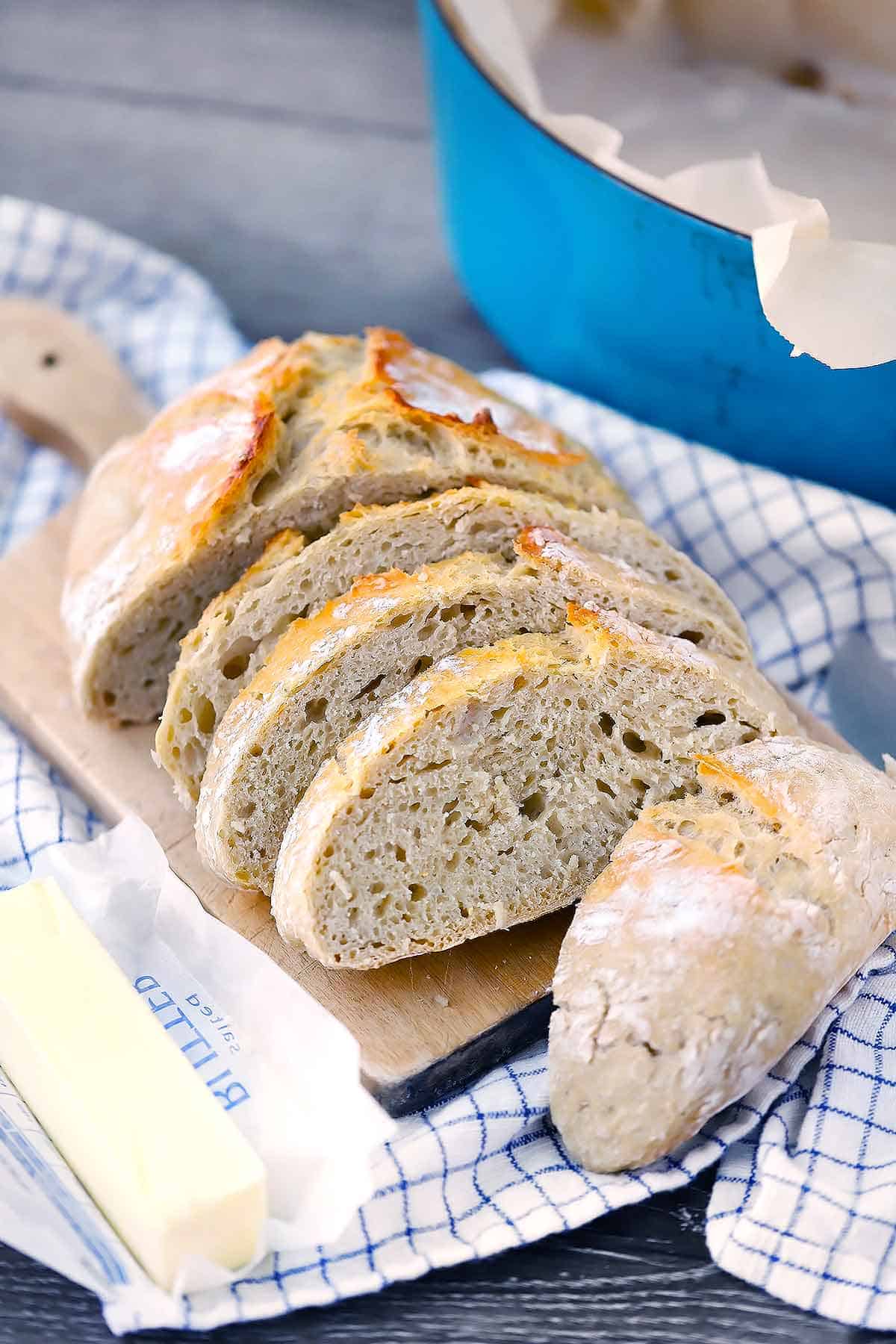
First of all, what is no knead bread?
No knead bread is, as the name suggests, bread that can be made without kneading the dough. No need to knead. Hah!
The dough is notoriously very loose and sticky, which can make it a little frustrating to work with (which is why I developed this method to not touch it at all- it takes a lot of that frustration away!).
No knead bread loafs do not need a second rise time, like a traditional loaf. The bread doesn’t have enough structure to rise “up,” and instead will flatten out and fill the shape of whatever you are making (Note: you CAN do a second rise time with no knead focaccia, which is a flatter bread type.)
The lack of a second rise results in two things: first, a faster overall time to make. And the second: it won’t have as many holes as a kneaded bread dough.
While I love a good fluffy artisan bread with holes for days, I think the pros here outweigh the cons. The bread DOES have some good holes, it’s got a great texture, and the fact that it’s so easy and hassle free is enough to make me never want to make a kneaded artisan loaf again!
How to make no knead dough
You only need water, yeast, flour, and salt for this no knead bread dough.
- First, warm the water (1.5 cups) to about 100 degrees F. A little more or less is fine. I usually measure it in my pyrex measuring cup and put it in the microwave for about 40 seconds, then take the temperature with a meat thermometer to make sure it’s the right temp. Don’t go any hotter than 110 degrees F – it might kill the yeast.
- Then, add the warm water to a large bowl, along with a packet of yeast, or 2.25 teaspoons (instant or active dry is fine) and 1/2 tablespoon of table salt (or 2 teaspoons kosher salt). Whisk together until the yeast and salt are dissolved.
- Finally, add the flour – 3.25 cups – all at once, and stir with a wooden spoon until everything is uniformly wet.
I like to use a silicone spatula to scrape the dough off the wooden spoon, as it will be quite sticky and loose.
Letting the dough rise
Once the dough is mixed, just cover it with a kitchen towel and let it rise in a warm-ish spot for two or three hours. It should double in size at least.
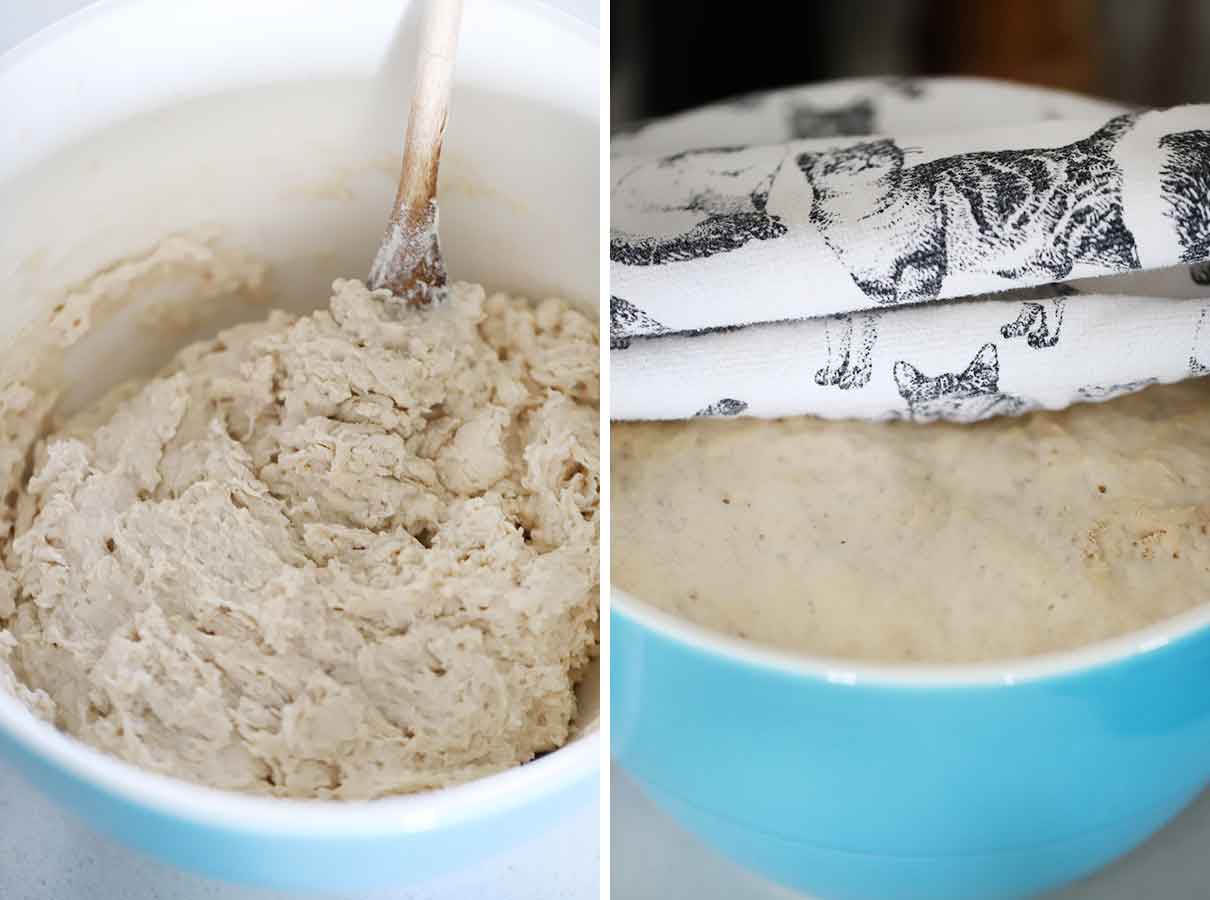
If your house is cold, I recommend turning your oven on for a few seconds, turning it off, and placing the bowl in the warm oven with the door closed to trap the heat in.
If you’re using your oven to cook something (or in the next step when you need to preheat your Dutch oven), you can leave the bowl on top of the stove- the vented heat at the top will help it rise well.
You can also get some really hot water in a mug or glass measuring cup, stick it in the microwave, and place the bowl next to it. Shut the door to the microwave- this will trap the warmth and steam inside.
If your house is warm, you can just leave it out.
If it’s warm outside, you can leave the bowl outside.
Storing the dough in your fridge
After the dough has risen for 2 hours, you can bake it immediately. But if you like, you can stick it in your refrigerator for up to 7 days until you’re ready to bake it!
Cold dough is a little easier to handle, so that’s a pro for this.
I recommend using plastic wrap or something more airtight to cover the bowl when you put it in the fridge. If you know you are making this dough days in advance, you can mix it up in a container, keep the lid on ajar while it’s rising and then seal the lid when you put it in the fridge.
The taste will get funkier as time goes on- by the 7th day, the bread will taste more like sourdough. And the dough will collapse over time- don’t worry about this.
Preheating the Dutch Oven
You want your Dutch oven to be good and hot for baking the bread so it gets a chance to crisp up properly on the outside.
About 30 minutes to an hour before you want to bake the bread, place the Dutch Oven, with the lid on, on the center rack of your oven and turn your oven on to 450 degrees F. Once it reaches 450, keep preheating the Dutch Oven for about 20 minutes.
Be very careful when handling the hot Dutch oven, as it’s very heavy and gets searing hot.
Forming the loaf
Here’s my favorite part! This is how to make the sticky mess of a dough into a loaf without having to touch it with your hands.
- First, lay a piece of parchment paper on your counter and sprinkle some flour on the bottom part closest to you.
- Then, use a silicone spatula to scrape the dough in a pile onto the floured part. Try to be gentle. The more you handle the dough, the more gasses escape, and the fewer fluffy holes there will be in the loaf.
- Use the silicone spatula to form it into a “loaf” shape, scooping up the dough from the bottom of the pile and placing it on top. You don’t need to do much of this- you just want it to be less of a “pile” and more of a “loaf.” You may also want to make it circular or oval shaped, depending on what shape your Dutch oven is.
- Finally, grab the corners of the parchment paper closest to you and use them to gently flip the loaf onto the center of the sheet of parchment. It may be a little misshapen, which is fine. If it bothers you, you can use the spatula to try to shape it some more but keep in mind, the more you handle it, the less fluffy the loaf will be.
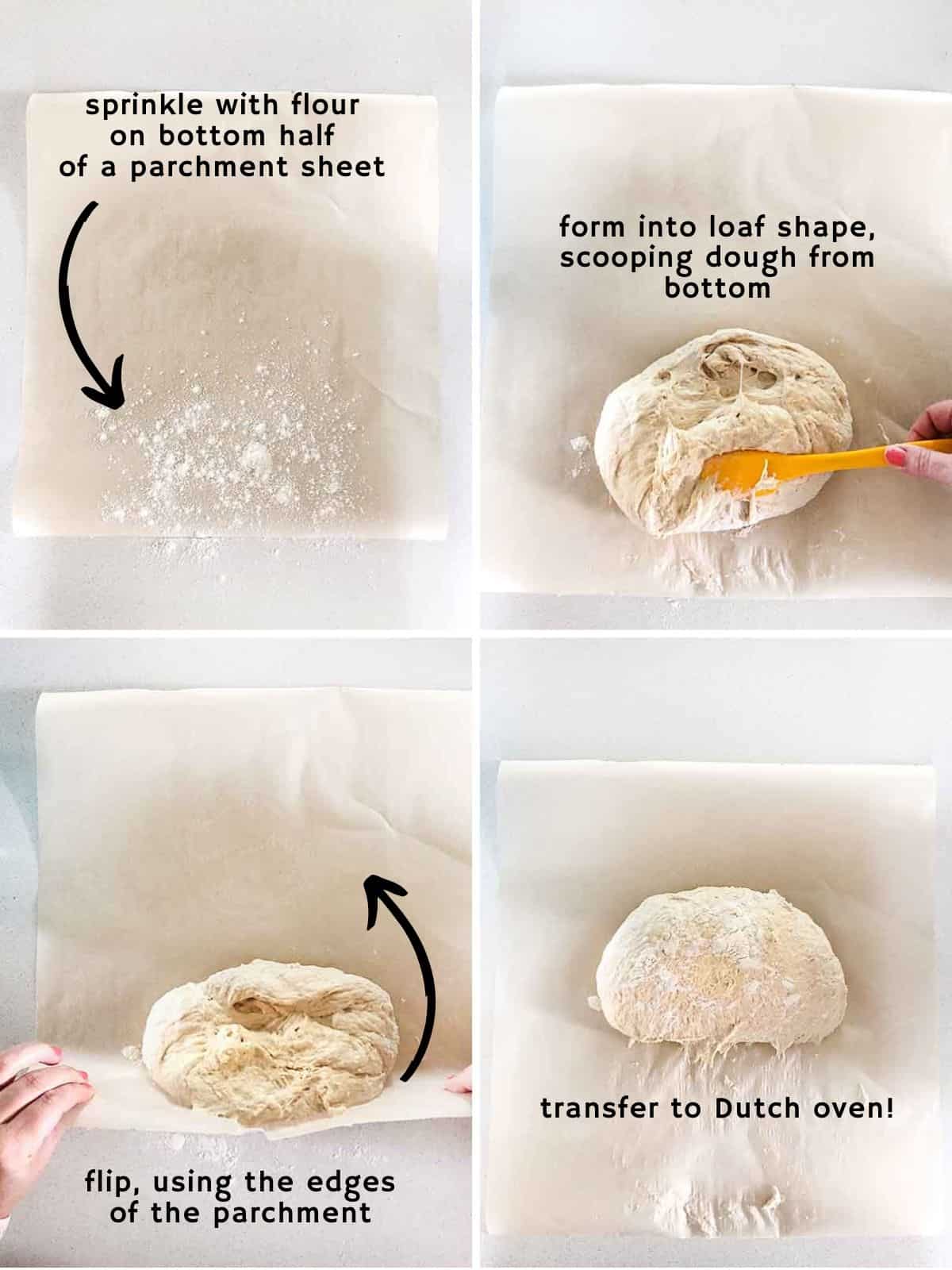
At this point, before putting it in the Dutch oven, you can use a very sharp knife or clean razor blade to make a few cuts about 1/2″ deep in the top of the loaf. I did this with mine in a cross shape from end to end in both directions. This will help it rise up a little more in the oven and get some browner crustier bits. But it’s totally optional.
Baking the bread
Once you have the loaf shape in the center of your parchment, open your oven door and take the lid off the Dutch oven (USING POTHOLDERS of course).
Then, grab the sides of the parchment paper and transfer the loaf to the Dutch oven. Place the cover BACK ON (USING POTHOLDERS FOR THE LOVE OF GOD), and bake at 450 degrees for about 35 minutes.
I know I keep yelling about potholders but too often I’ve reached absentmindedly for the lid of a Dutch oven thinking it’s going to be cool but it’s searing hot. It’s easy to make that mistake!
Once the 35 minutes are up, take the lid OFF, and bake for another 5-10 minutes, until it’s golden brown.
Stop for a moment, and inhale deeply. The smell of fresh-baked bread is one of the best things in the world.
Finally, remove the bread by holding the parchment paper, and place on a wire rack or a cutting board to cool. You want it to cool for at least 10 minutes before slicing.
AND YOU’RE DONE! Congrats on your gorgeous artisan Dutch oven bread!
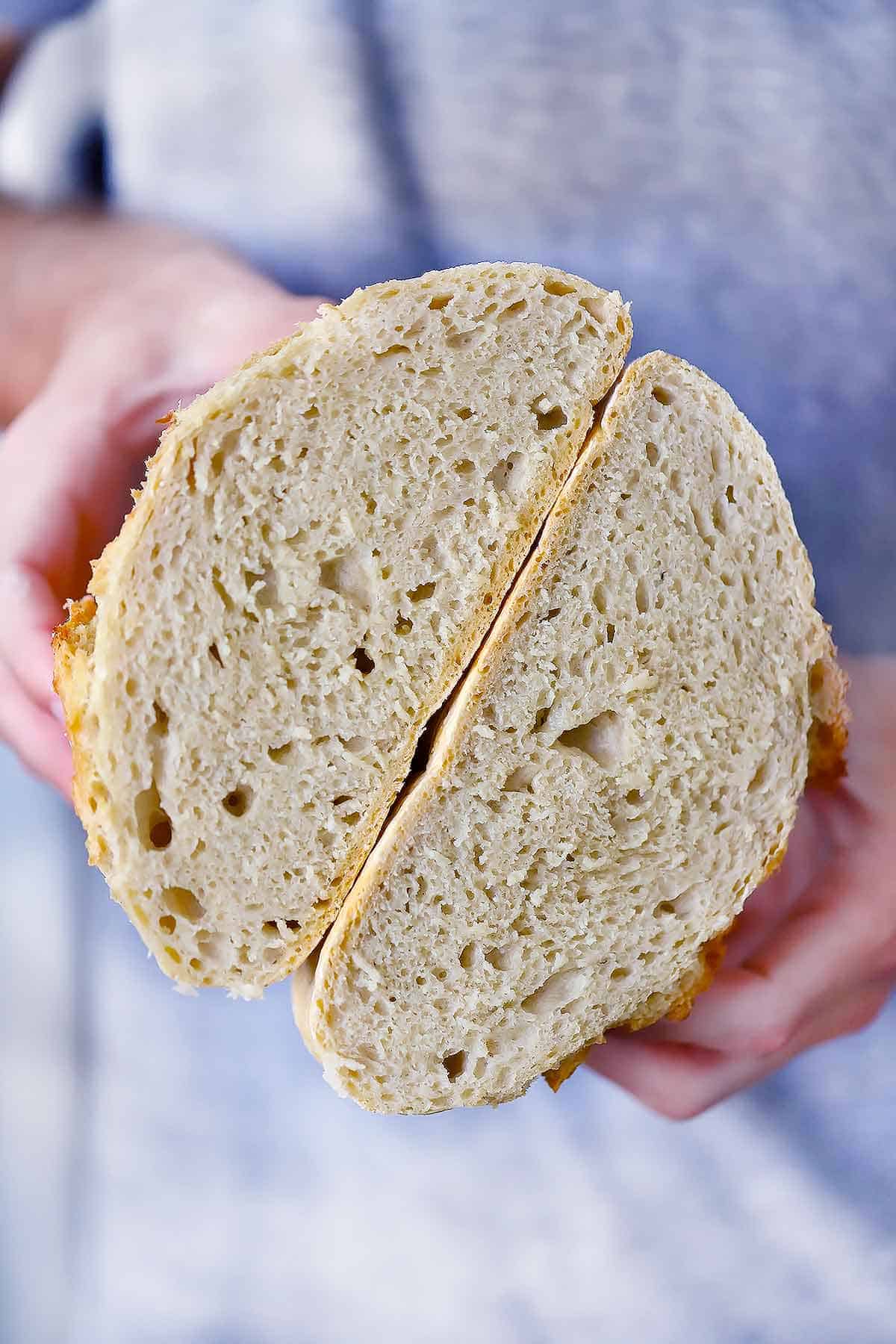
Why does the lid to the Dutch Oven need to be on while it bakes?
The key to moist bread with a perfectly crusty crust is that it needs to be baked in a humid environment. I know it seams counter-intuitive, but it really works.
The lid to the Dutch oven traps the steam from the sticky dough inside, making it a perfect bread baking environment.
Then, taking the lid off for the last bit of cooking helps really brown the top of the loaf without it over-drying.
It’s truly a miracle to behold. And it’s why we can call it “artisan bread!”
But what if I don’t have a Dutch Oven?
Glad you asked.
This bread is possible to make without a Dutch oven, but you won’t get the same amazingly crusty results. Don’t let that stop you- just temper your expectations a bit.
You can bake the bread, on parchment paper since the dough is so sticky, on a baking sheet or, preferably, in a preheated cast iron skillet.
Here’s what you can do to help make it extra tasty with a crusty crust.
Create a humid environment in your oven by placing a rimmed baking sheet on the bottom rack while the oven preheats. When you add the bread to the oven, pour about 4 cups of water onto the preheated baking sheet. This will create steam as the cold water hits the hot metal. Close the oven door as fast as you can to trap the steam inside.
Can I use another kind of flour?
I used all-purpose for this crusty artisan bread, but you can use bread flour if you like.
You can also use part whole wheat flour– I recommend substituting 1 cup of the AP flour with whole wheat. A 100% whole wheat loaf has not been tested, but it might work.
I haven’t tried using a gluten-free flour mix for this and therefore cannot recommend it. Here’s a gluten-free artisan bread that might be helpful for you!
And finally, you should never substitute a non-flour flour, such as almond flour or chickpea flour, for AP flour. Those won’t work with this bread.
Wait- don’t I need sugar to make bread?
Nope! Some people thing you MUST use sugar in bread or dough recipes so the yeast have something to eat. While yeast do love sugar, and adding sugar to dough can cause a more rapid rise time, it’s not necessary. Yeast love to eat flour too (which is a carbohydrate just like sugar, so acts in a similar way). So you don’t need sugar in this no knead bread recipe at all!
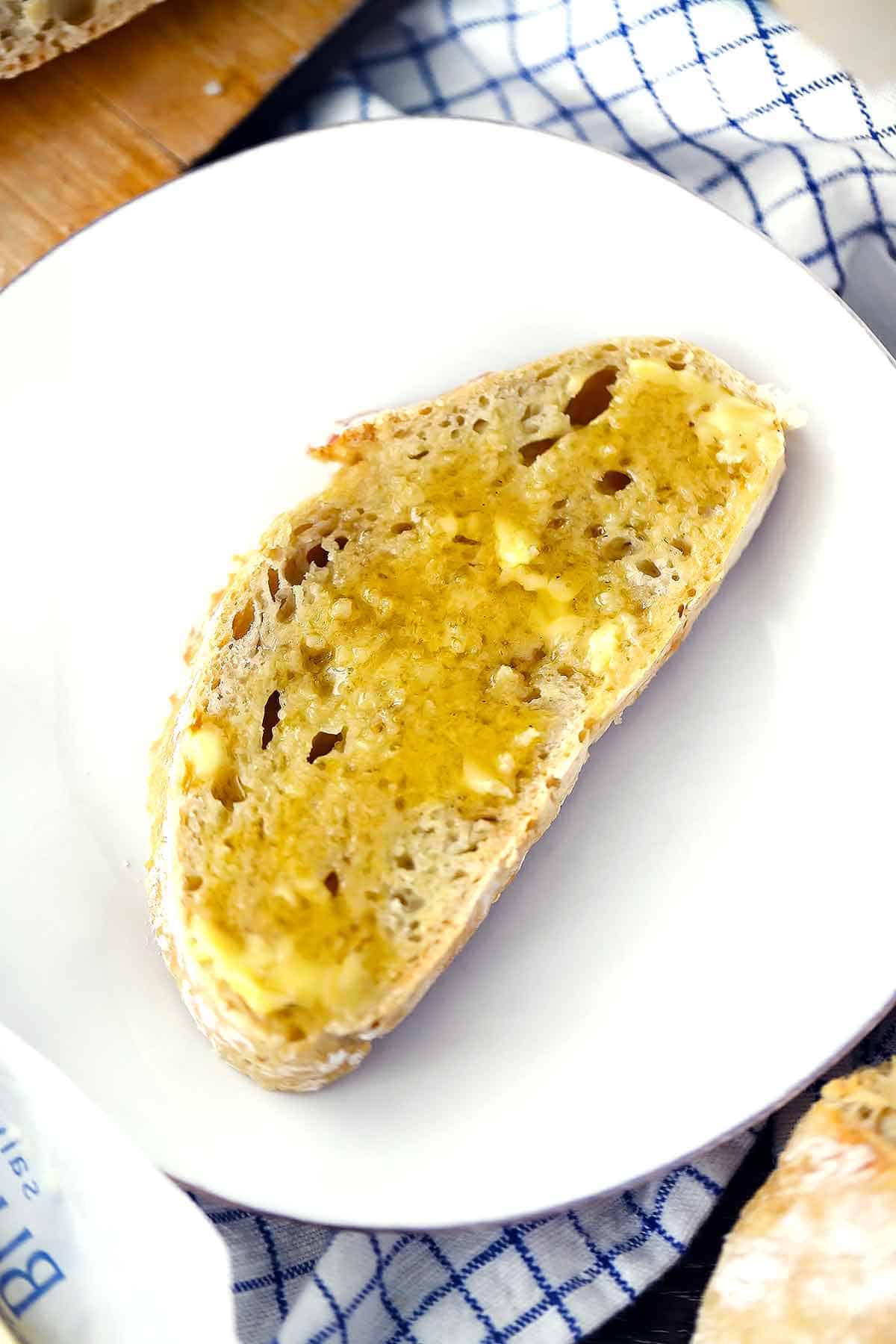
Can I freeze it?
Yes!
The bread stays good at room temperature in a plastic bag or airtight container for about 2 days, and it will get staler as time goes on. Any longer than 1-2 days, and you should freeze it.
You can freeze the loaf whole if you like- you’ll just need to leave it out for about 12 hours before you can slice into it.
Or, you can slice it before freezing, which enables you to take out one slice at a time for toast or sandwiches.
Here are some tips for freezing:
- Store the whole loaf or sliced loaf in an airtight bag, squeezing out as much air as possible. This will help prevent freezer burn.
- Wait until it’s COMPLETELY cool before storing, especially if you’re slicing it before, as the slices may stick together if you don’t.
It should stay good for 2-3 months in the freezer if stored properly.
Why didn’t my dough rise?
If your dough doesn’t rise, it is likely an issue with the yeast itself. Yeast is a living organism and needs to be able to eat food and multiply in order to cause a rise. As they multiply, they release gasses, which causes the airy pockets in the dough. Here are three reasons why your dough may not be rising:
- The yeast is dead to start out with. This can happen if the yeast is old, or sometimes even if you get a dud pack of it. A new pack of yeast from the store can sometimes make all the difference!
- The conditions don’t allow for the yeast to multiply. This usually happens if the temperature is too cold. At cooler temperatures, yeast may multiply much slower, or not at all.
- If the yeast is killed by accident. This can happen if the water temperature is too hot when added to the yeast, which can kill the yeast and subsequently cause no rise. (Note: it is a MYTH that salt kills yeast in this way! If you were to use tons of salt, it may kill the yeast, but the amount of salt used in this recipe won’t kill the yeast – at worst, it may just slow the multiplication process a little bit.
If your dough won’t rise, my advice is to start anew with brand new yeast and make sure to measure the temperature of your water with a thermometer – I love the Thermoworks Thermapen for a super fast, accurate read! Alternatively, you can stick your finger in the water and it should be about body temperature, so if it feels neutral or slightly warm you should be good!
How to serve an artisan bread loaf
I’m a big fan of eating the bread smeared with salted butter and drizzled with honey, as pictured above. But this homemade bread would be delicious…
- Served with a hearty soup, like split pea soup or lentil soup.
- Used for a fancy grilled cheese, like this leek and gruyere grilled cheese.
- To make cold sandwiches, like this fresh mozzarella, tomato, and basil sandwich with balsamic glaze.
- Served sliced with a basic olive oil and balsamic bread dip, as a side to your favorite Italian pasta recipe (like this five-ingredient pasta with Bolognese sauce).
- Used to sop up the sauce from classic shrimp scampi.
What to make with the stale bread
If you forget about the bread and leave it out at room temperature for more than a couple days, it may go stale. I hardly ever have this happen, as my family and I inhale the entire loaf in one sitting usually. But there are a few things you can do with the leftover stale bread!
Here are my favorites:
- Make homemade croutons with it
- Use it in Panzanella salad
- Make a Tuscan Tomato and Bread soup
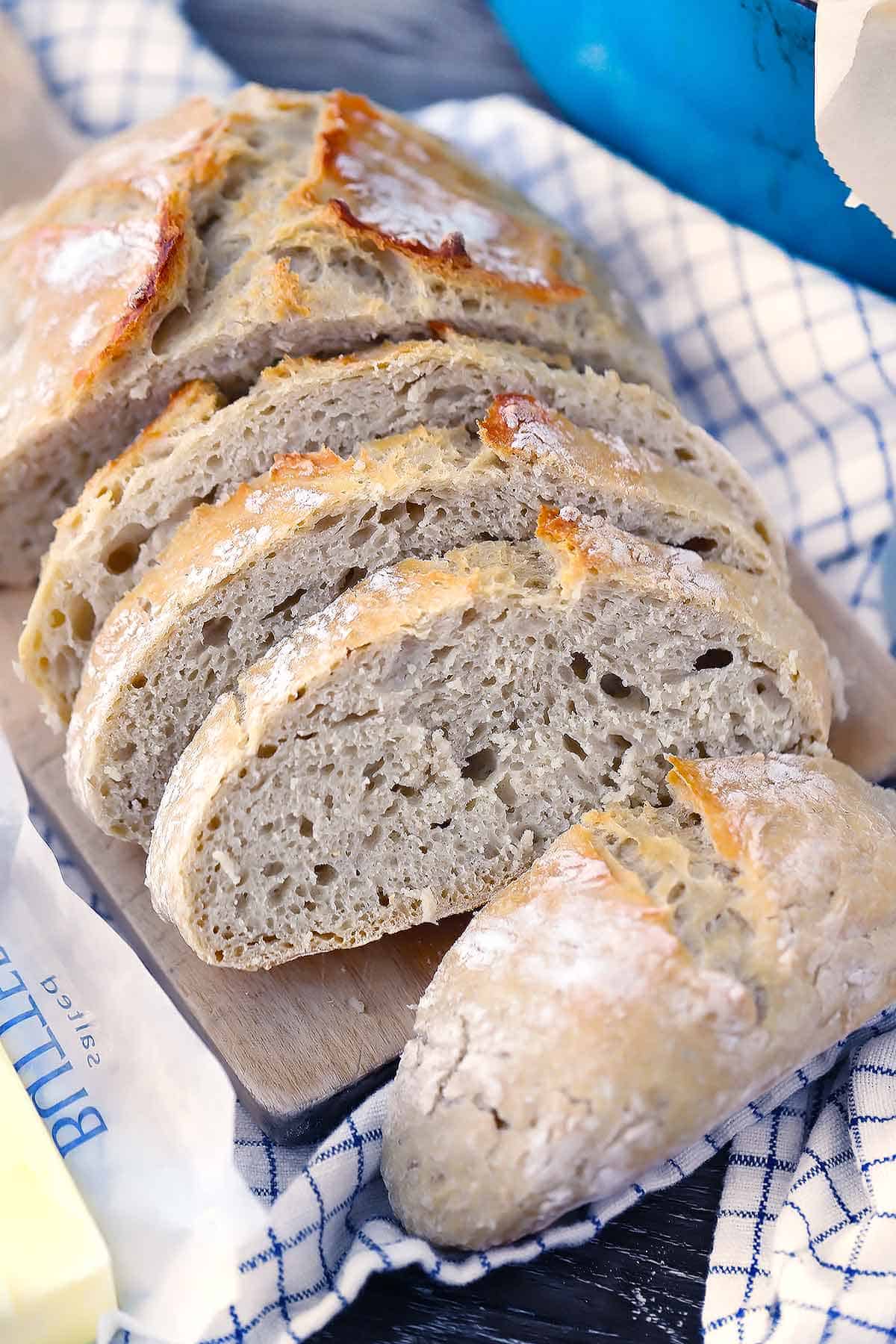
Do I HAVE to preheat the Dutch Oven?
No. I’ve made this plenty of times putting the loaf into a cold Dutch Oven and then baking for an extra 5-10 minutes with it covered. Preheating the Dutch Oven before baking the no knead bread can help get it a taller rise while baking, since it will start baking faster and more rapidly. But if you are concerned about preheating your Dutch Oven while it’s empty, as some manufacturers recommend not to do, or if you want it to just be a little easier/safer, feel free to skip this step!
How can I add other ingredients to the dough?
Once of the most common questions I get for this recipe is “Can I add herbs and cheese?” or “Can I add jalapenos and cheddar?” YES! It’s SO easy to add other ingredients to no knead bread.
Just add whatever other ingredients you want when you mix the dough together. Let it rise with all those ingredients, and then shape and bake as directed. You may even want to sprinkle the top with some extra ingredients. For example, sprinkle with grated parmesan or cheddar cheese, or brush with olive oil and sprinkle with rosemary and sea salt.
One thing to keep in mind: if you add ingredients with moisture, such as rehydrated dried fruit, olives, or pickled jalapeños, you will need to drain them very well and/or add less water to the mix. It’s not a huge deal, as this recipe doesn’t require a super exact ratio of liquid to flour, but keep in mind that extra moisture may affect outcome a little bit.
Here are some suggestions for no knead bread flavors:
- Jalapeño and Cheddar – add drained pickled jalapeños and grated or cubed cheddar cheese. Grated cheese will melt into the dough and flavor the whole thing, while cubed will maintain its shape and create melty pockets of cheese.
- Rosemary and Sea Salt – add chopped fresh rosemary to the dough, and before baking brush the top with olive oil and sprinkle with extra rosemary and a sprinkle of sea salt.
- Herb and Parmesan – add a medley of fresh or dried herbs to the dough, as well as grated parmesan. Sprinkle the top with extra herbs and parmesan after brushing with olive oil, if you want.
- Olive – add well-drained olives to the loaf. Whole or chopped, depending on how big you want them in the final thing. This is also great paired with the rosemary and sea salt or herb and parmesan combo above.
- Cinnamon raisin – let some raisins soak in warm water for a few minutes to plump up, drain well, and add them, along with some cinnamon, to the dough. You may want to add a little sugar to the dough as well here – this may cause a faster rise time, since yeast love sugar, so keep that in mind. Here’s a more detailed post on how to make cinnamon raisin no knead bread!
There are so many other ways to play around with other flavor combos- I’d love to hear about them in the comments!
Other easy yeast bread recipes
- Quick and Easy Dinner Rolls
- Vasilopita (Sweet Greek New Year’s Bread)
- Whole Wheat No-Knead Focaccia with Rosemary and Sea Salt
- Honey Whole Wheat Pizza Dough
- White Sandwich Bread (from The Brown Eyed Baker)
Check out all my homemade basic essential recipes here.
I also LOVE using my Dutch oven to roast a whole chicken.
Did you know commenting and rating recipes is one of the best ways you can support your favorite food bloggers? If you made this Dutch Oven No Knead Artisan Bread, please click the stars below to comment and Rate this Recipe
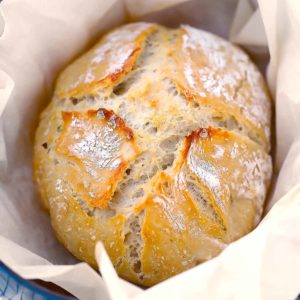
Dutch Oven No Knead Crusty Bread
Equipment
- Silicone Spatula
- Meat Thermometer for taking accurate temperature of the water
Ingredients
- 1 1/2 cups warm water (about 100 degrees F)
- 1 packet yeast (active dry, instant, or quick rise- 2.25 teaspoons)
- 1/2 tablespoon fine grain salt (preferably NOT iodized, see notes)
- 3 1/4 cups all-purpose flour or bread flour, more if needed to get correct consistency, plus more for dusting (I use King Arthur AP flour – other flours may yield different results)
Instructions
- In a large bowl (or container), mix together the warm water (1.5 cups), yeast (1 packet/2.25 teaspoons), and table salt (1/2 tablespoon), until yeast and salt are fully or almost dissolved (I like using a whisk for this).
- Add the flour (3.25 cups) to the bowl all at once and stir together until a sticky dough forms. Don't worry about mixing it too much, just make sure everything is uniformly wet. It WILL be messy and sticky. You can scrape what's left on the spoon with a silicone spatula. (photo below provided for what the texture should look like – if it seems too wet, add 1-2 tablespoons more flour at a time until it is more like the photo. If it seems too dry, do the same thing with more water).
- Cover the bowl with a kitchen towel (or place the container to the lid on ajar). Leave it for 2-3 hours to rise in a somewhat warm place until it's doubled in volume, like photo in previous step (If it's cold out, I like to preheat my oven for a few minutes, then turn it off, then place the bowl in the oven, trapping the heat inside. If your house is warm just leave it out, or if it's warm outside you can place it there).
- After the two-three hour rise time when the dough has about doubled, you have two options: bake, or store in the fridge. See notes for how to store.
- 30 minutes to an hour before you are ready to bake, preheat your oven to 450 degrees F. Place your Dutch oven in the oven, with the lid ON, while the oven is preheating. Once the oven reaches 450, keep it preheating for another 20 minutes, so the Dutch oven gets good and hot.
- Scrape the dough into the edge of a piece of parchment paper dusted with flour. Make it into as much of a "loaf" shape as you can by folding the edges up on top of it (a silicone spatula works well for this).
- Then, use the edges of the parchment paper to flip the loaf over so the floured side is on top and the loaf is in the center of the parchment paper. Don't worry about it looking beautiful or smooth on top. My Dutch oven is an oval, so I made an oval shape. You can do a circle if yours is round.
- Optional: use a very sharp knife or clean razor blade to cut a few slits across the top of the loaf about 1/2" deep, across the entire top. I did this in a cross shape for mine.
- Take out the preheated Dutch oven and take off the lid, carefully! Grab the parchment from the sides and place the loaf in your Dutch oven.
- Place the cover back on the Dutch oven and place in the preheated oven on the center rack. Bake for 35 minutes at 450 degrees F (40 minutes if dough was cold from the fridge). Remove the lid and bake for another 5-10 minutes, until a golden brown color forms- longer if necessary. Remove the loaf from the dutch oven (grabbing the sides of the parchment paper works well here) and place it on a wire rack or cutting board to cool for at least 10 minutes (preferably 30 minutes – an hour, if you have time) before slicing.
Notes
- Dough too wet/dry: some readers have commented that the dough is too wet. This can happen based on a few variables, including type/brand of flour and accurate measurements. See photo in post and recipe instructions – if texture doesn’t seem similar, add 1-2 more tablespoons flour or water as needed.
- Make two small loaves instead: You can make two smaller by using only half the dough at a time, saving some in the fridge for later. Once the dough has risen, you can take out half of it to divide it in half. Using a serrated knife to cut the dough in half directly in the bowl is a great way to do this, as it won’t deflate the dough as much. I recommend cutting the cooking time to 20-25 minutes covered if you do this. Alternatively, you can double the recipe to make two large or four small loaves, leaving the extra dough in your fridge for fresh bread every few days! Use a serrated knife to cut the dough into pieces, trying your best not to squish it down as you handle it, and make sure you use a very large container or bowl for this.
- Fine grain salt can be fine sea salt, Himalayan salt, or any other salt you prefer.
- Iodized salt is not recommended, but can be used if that’s all you have. The iodine in the salt may impart a bitter taste in the bread and it also may inhibit the growth of yeast, leading to a longer rise time.
- Kosher salt may be used instead of table salt- I recommend 2 teaspoons since it’s a larger grain. Same goes with coarse sea salt.
- Avoid “gummy” bread by allowing it to cool for a longer time. I often can’t resist and just tear into the thing after 10 minutes, but often the inside seems gummy, and almost raw, because it’s too steamy to cut into. Waiting a whole hour, if you can manage, is ideal.
- Super hard, tough bottom crust? Next time, try putting a baking sheet on the bottom rack of the oven. It will help divert some of that high heat away from the bottom of the Dutch Oven as it bakes.
- Some Dutch Oven manufacturers recommend NOT preheating an enameled cast iron Dutch Oven empty. It may result in the enamel cracking. I’ve never had a problem with my Lodge Dutch Oven, but if you’re nervous about it, you don’t have to preheat the Dutch Oven. Just put the dough in the cold Dutch Oven and bake for 5-10 minutes longer covered, and you should be good to go!
- How to store dough in fridge: If storing in the fridge, leave the lid ajar or use loose plastic wrap covering the bowl so gasses can escape. Storing it in the fridge makes the sticky dough a bit easier to handle, and it also enhances the flavor, so I recommend refrigerating it for at least 12 hours. It can stay in the fridge for up to 7 days! After two days, you can seal the lid to the container or cover the bowl tightly with plastic wrap. The taste of the bread will get funkier the longer it stays in your fridge. By the 7th day, it will taste more like sourdough.
- Since cold dough is easier to handle, you can place the dough in the fridge for 30 minutes or so after the two hour rise time, just before baking, so it’s easier to scrape out and form.
- If using cold dough from the fridge, I recommend baking for 5-10 minutes longer with the lid on (40-45 minutes instead of 35 minutes).
- Dutch Oven Alternatives: The Dutch oven does a really good job of trapping the steam, ensuring a crusty, golden brown loaf. If you don’t have a dutch oven, you can bake this bread on a baking sheet or in a cast iron skillet. I recommend adding some water to a rimmed baking sheet, or other oven-safe dish, and placing it in the oven on the lower rack, to add steam to the oven and help develop a crusty crust.
- Freeze the baked bread by slicing it first, then storing it in a zip-top bag, squeezing out as much air as possible. The bread should be completely cool before freezing. You can also freeze a whole or half loaf without slicing, wrapped tightly in plastic wrap, but you’ll need to wait to defrost the whole thing before slicing into it.
- Dutch Oven Size: I use my oval 5.5 qt. Dutch Oven or my 6 qt. round Dutch Oven for this recipe. There is some wiggle room, so you can go a little smaller if you like, especially if the parchment paper comes up the sides to prevent sticking. And you can definitely go bigger if you want.
- Parchment paper trick: crumple up the parchment before using it, to help it mold to the shape of the Dutch oven better.
- Sticking to the parchment paper: A few readers have noted that their bread sticks to the parchment after baking. This usually does NOT happen, as parchment paper is non-stick. However, after doing some research, I found that sometimes using a very cheap brand of parchment paper can result in the bread sticking. I recommend using a “nicer” brand of parchment paper, or brushing or spraying it with a little bit of oil or nonstick spray before placing the shaped loaf on the paper and baking it.
- Parchment paper at high temperatures: Some readers have expressed concern over the high temperature used for parchment paper. I’ve used parchment rated to 420 degrees for this recipe with no issue, but you can buy a parchment paper rated to 450 degrees if you are concerned. Here’s a great article about using parchment paper at high temperatures. As a general rule, keep an eye on what you are cooking, for any recipe!
- Avoid too much flour on the outside of the bread: You can use a pastry brush to brush away any thick layers of flour – before baking is best but after works too! You can also spritz the outside of the loaf with some water from a spray bottle, which also can add some lovely blisters to the crust.
- For a hard, too crusty bottom of the loaf: try putting a baking sheet on the bottom rack of the oven while baking. It helps deflect some of that direct intense heat away from the bottom of the Dutch Oven, resulting in a softer bottom to the loaf.
- Dry dough? Some readers have commented that their dough is dry, not wet and sticky. If this happens, it may have something to do with the brand or type of flour, or measuring discrepancies. Jut add a little more water until it’s a little looser and you should be good to go!
- High Altitude? A reader did this at a high altitude and she said she just added a little more water to the dough (about 1 tablespoon) and kept the towel damp during the rise time.
- Adding other ingredients: Feel free to mix in other ingredients, like herbs, roasted garlic, parmesan cheese, etc. with the rest of the ingredients! Then let it rise, shape, and bake according to instructions. See more about this in the body of the post with flavor suggestions.
Nutrition
Nutrition Information Disclaimer
The provided nutrition information is my best estimate and does not include any added sodium from seasoning to taste, any optional ingredients, and it does not take brands into account. I use an automatic API to calculate this information. Feel free to calculate it yourself using one of these tools:


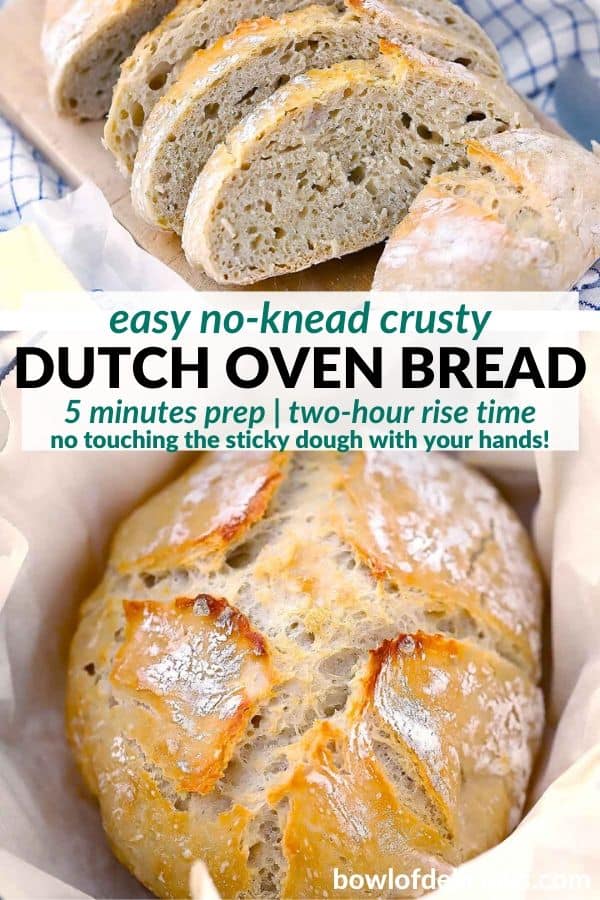
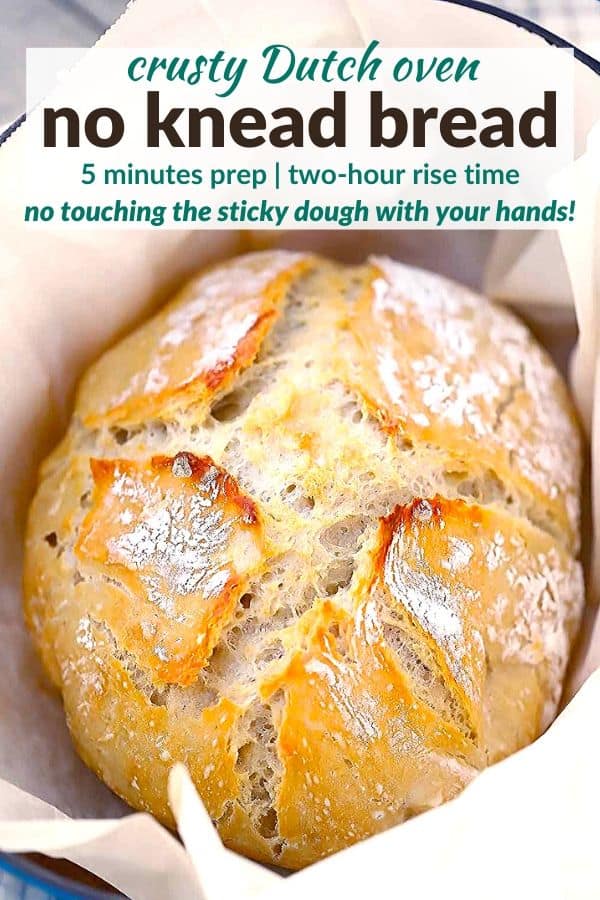
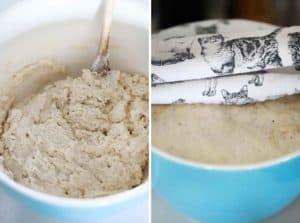
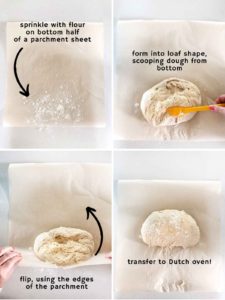
Bebe
I have used other recipes for Dutch Oven bread, but this is by far the best one I’ve tried. Results were amazing and it made me so happy! (After the 2 hour rising, I had to put the dough in the fridge. I baked it when I got home around 4 hours later. It came out awesome!)
Elizabeth Lindemann
So glad you liked it!
MeatButt
This bread is my best loaf so far! I did add a tiny sprinkle of white sugar when I was blooming the yeast because they love it lol
The dough is firm enough before baking that I can practice my “bread art” with the scoring.
I will be using this recipe again!
Elizabeth Lindemann
So glad you liked it! I definitely need to practice my bread art – still haven’t nailed it yet but it’s so interesting and beautiful! Good for you :-)
Su
Delicious recipe! Directions are easy to follow, with great results 🥰
Elizabeth Lindemann
So glad you liked it!
Kathy
Just tried your bread…..one word….Delicious!
Elizabeth Lindemann
So glad you liked it!
Karen Lindemann Fortier
Really love this easy recipe and the delicious results. I made one loaf in the Dutch oven and one on a baking sheet. Both were exactly as we’d hoped for! This bread is especially good with my soups and stews made from family recipes.
(p.s. my maiden name is Lindemann, but we are not related – as far as I know!)
Elizabeth Lindemann
So glad you liked it! Lindemann is my married name as well, I do believe there are a lot of us out there, but maybe some distant cousins or something! :-)
Michelle
I had recently tried a more complicated recipe with less than desirable results. Then I decided to try this recipe and it was so easy and really good! I added rosemary and my house smells yummy. This is a keeper!
Elizabeth Lindemann
So glad you liked it!
Jan
I’m making now but I’m not sure how much parchment paper should be left outside of the Dutch oven or if you tuck it inside while baking. A picture of that would be helpful. I’ll let you know how it turned out (I ended up tucking it in since I was afraid of it burning. ??)
Elizabeth Lindemann
Great question! I always tuck my parchment paper in, as there isn’t a ton overhanging it.
Jan
It turned out great! My husband said it was the best homemade bread I’ve ever made. I used 1 cup of whole wheat flour.
Elizabeth Lindemann
So glad you liked it!
Robyn
I left my parchment paper out. It didn’t do anything or catch fire or interrupt the process. It was “crunchy” when I took out the dutch oven, but nothing extraordinary happened. I was afraid if I tucked it in it would ruin or “interrupt” the process.
Elizabeth Lindemann
Thanks for letting us know!
Cindy
Just made this bread! Looks amazing coming out of the oven. Can’t wait to dig into it!
Elizabeth Lindemann
So glad you liked it!
Rebecca Doty
I make two batches of dough every week, I bake one and save the other in the fridge to bake in a few days. This is so easy and delicious, my kids and I can’t get enough! This has been my go to recipe and method for a couple years now, it’s the best and my two and six year olds can make it with minimal help (except the oven part of course)!
Elizabeth Lindemann
So glad you liked it!
Paula
Made this tonight to go with sausage and pasta soup. My family enjoyed it and so did my neighbors! We all polished off the whole loaf. Will be making this again in the morning because the kids requested avocado toast with this bread.
Elizabeth Lindemann
So glad you liked it! Great idea to use it for avocado toast. I recommend, after toasting the bread while it’s still warm, drizzle some olive oil on it and then rub the cut size of a garlic clove on top. The garlic flavor will infuse into the warm oil. SO GOOD!
Erin
Easy… love the detailed directions and I followed them precisely. Delicious!!!
Elizabeth Lindemann
So glad you liked it!
Lucy Higgins
Too dense, heavy, not enough holes. Followed instructions carefully
Elizabeth Lindemann
No knead breads can be finicky especially if you’re new to them! There isn’t as much gluten development and strength because it’s not kneaded, so the dough should be handled carefully so as not to deflate too many holes. Other issues that may leave to dense bread may include: substituting some or all AP flour with a whole grain flour, over-proofing or under-proofing the bread, using a bleached or brand of flour that doesn’t have as much gluten content. Next time, I’d recommend: a) making sure you use a good quality flour (I like King Arthur AP flour or bread flour – you need to add a little more water with bread flour), b) giving it a little extra time stirring together in the beginning, which will help develop more gluten from the start, and c) keep practicing with turning out the dough from the bowl and forming the loaf! Hope that helps :-)
David
How much more water would you recommend when using bread flour with this recipe?
Elizabeth Lindemann
I’d try 2 tablespoons at first and then add more if the dough seems too dry.
Lucy Higgins
If dough sticks to bowl after rising, dump dough in clean bowl sprayed and dusted before setting to rise.
Elizabeth Lindemann
Thanks for this tip!
Sherelyn
Awesome recipe! Tried this for the very first time and the result was amazing! I added herbs and some grated cheddar cheese and we loved it. My only problem was the parchment paper stick to the bottom of the bread, never happened to me before when baking other breads. What should I do to keep that from happening? Thanks for the recipe once again!
Elizabeth Lindemann
So glad you liked it! There’s a recipe note about this – it seems that some brands of parchment paper perform better than others. Some people have noted that the cheap parchment from Aldi sticks like crazy. You may want to try another brand! And do double check you didn’t use wax paper by accident – that’s a super common mistake :-)
Jenn
I don’t have a Dutch oven and the only cast-iron pan I have is a skillet. I have ceramic ovenware and one of those white-with-red-edging old-fashioned metal pans that look like Dutch ovens. Would either of those work?
Elizabeth Lindemann
Anything that is oven-safe with a cover will work! You may wish to skip the pre-heating phase for something that heats quickly or that you are unsure of, like those thinner metal pans.
Monica
Came out perfect the first time though my dough was not wet so I added more water- about an 1/8 of a cup or a splash. This helped make it wet. I used AP flour. Also putting the sheet pan under helped the bottom come out perfect. Is a great foundational bread recipe especially for me wanting a good quick crusty bread to bake weekly. I want to add more flavor- possibly cheese this time or herbs. I presume I can during the initial mixing: pre-rise? Thanks!
Elizabeth Lindemann
So glad you liked it! Yes, add any additions during the initial mixing.
Lise
Hi,
I made this recipe tested by couple of friends who really like it. Out of the blue I decided to add buckwheat flour to the all purpose flour, so I used2 cups of all purpose and 1.25 of buckwheat. The dough turned out brownish, color of the buckwheat.
As I didn’t have parchment paper, I used wax paper, crossing my finger that it would do the job- well we use it when baking cakes, aren’t we ( at lesdt used to back in the days -I’m 59 years old, and parchment paper was not in our kitchen when I was a child).
Results: cooked as per the instructions. The bread did not rise as much as it would probably have without the buckhweat flour and it was heavier when compare to white bread. Wax paper worked well, but I will try without paper at all in the pot next time. I don’t think it’s necessary.
The real test was when it was time to slice it, look at the crumb, and eat it. Crust is hard, but not too thick. There are small holes in the crumb. I toasted my first slice. Takes more time to toast the way I like it, but it was actually very good! Of course you need to like buckwheat, which has a strong nutty taste. Overall my experience with adding different flour ended up well.
Next time I’m doing it with just all purpose flour as my hubby does not like how buckwheat taste! ;)
Elizabeth Lindemann
So glad you liked it! Thanks for letting us know how it is with buckwheat – sounds delicious!
Susan
So easy and soooo good! Wish I could post a picture! I didn’t change a thing and it was perfect!
Elizabeth Lindemann
So glad you liked it!
Pat Merrifield
Loved this recipe!! Worked like a charm!! I let the dough raise near our wood stove because it was sub zero outside and the house was a bit drafty. It was double the size in two hrs!
Thank you for the wonderful instructions!
Elizabeth Lindemann
So glad you liked it!
Melanie
This bread is excellent and so easy! Thanks for the great recipe-we make it all the time and the leftovers make the best grilled cheese!
Elizabeth Lindemann
So glad you liked it!
Mary
Delicious! I used bread flour and let the dough rise overnight and most of the next day before baking it. I did have a problem with the parchment paper sticking to the bread and will be picking paper off the bottom of the loaf until it’s completely consumed. The bread has a great crust. However, the rest of the bread turned out to be very soft and was difficult to cut without smushing. This made it difficult to cut even slices (yes, I did use a bread knife). But I am very pleased with how this turned out. I will experiment with the parchment paper, play with the flour to water ratio, and will make it again.
Elizabeth Lindemann
So glad you liked it!
Rachel Campbell
This did not work out for me the first time (which was also my very first attempt at making any kind of yeast bread at all). I followed each step, using fresh all-purpose Gold Medal flour, pink himalayan sea salt and brand new yeast, water at the correct temp. After doing some further research, I realized that the step of waiting 5-10 minutes to allow the yeast to bloom was missing from the directions. In each recipe I read this seemed to be an important step to activate the yeast. I also added a pinch of sugar to the yeast mixture. After adding this step on the second try, it turned out beautifully.
Elizabeth Lindemann
Glad it worked the next time for you. I personally use King Arthur all purpose flour, I haven’t used Gold Medal before. Do be sure to use unbleached flour. You don’t need to let the yeast bloom in water before adding the other ingredients it can help speed things along (and it also enables you to make sure your yeast is alive and active before adding the flour to it).
Kaitlyn
This turned out amazing!! Will definitely be making this weekly and not buy grocery store bread. I used bread flour and we ate half the loaf last night. :)
Elizabeth Lindemann
So glad you liked it!
Melissa
FIRST: I’ll admit it – I’m intimidated by the idea of baking bread. My mom was great at it, my sister is great at it, I’m just intimidated.
NOW – in the last two weeks, I have made this twice (or versions of it) and LOVE IT. The first time I followed the recipe (but added about a TBSP of Italian Herbs and about 1/2 cup pre-shredded cheese (just a cheddar / jack blend, nothing fancy). Slightly herby, slightly cheesy, a great hit. Second time I substituted 1/4 cup of flour with whole wheat flour – and added sunflower seeds. Also a HIT! Next time I’m going to go for a touch of rye flavor. I love this recipe / method!
Elizabeth Lindemann
So glad you liked it!
Amy
Just made a gluten free version using your recipe with Krusteaz all purpose gf flour! It’s the best I’ve made so far! I did have to add some extra water as the gf flour was a bit drier, but it turned out great and I can’t wait to make a rosemary garlic version!
Elizabeth Lindemann
Oh wow, thanks so much for chiming in about your gluten-free version! So glad you liked it!
Darrin
Hi there…is this for a 1 or 2 pound loaf?
Elizabeth Lindemann
I believe it’s 2 lbs.